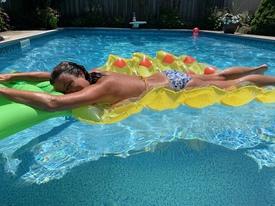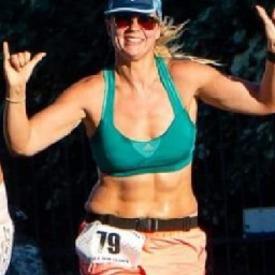Calves hurt when running

tomhurst
Posts: 47 Member
I've been doing interval running (I'm not every fit so don't judge) on the treadmill at the gym.
I do 2 and a half minutes of running, then the same walking, and keep alternating.
However when I run my calves kill, and I just can't run sometimes because it really hurts.
I've tried waiting 3 days for it to repair, but it still hurts. I always have a protein shake after the gym, and I don't do any weights for my legs..
Anyone know why?
Could it be my shoes? I got a pair of discounted running trainers at sports direct, but maybe it's them and they're rubbish?
It hurts at the back and inside of my calves.
Thanks! a
I do 2 and a half minutes of running, then the same walking, and keep alternating.
However when I run my calves kill, and I just can't run sometimes because it really hurts.
I've tried waiting 3 days for it to repair, but it still hurts. I always have a protein shake after the gym, and I don't do any weights for my legs..
Anyone know why?
Could it be my shoes? I got a pair of discounted running trainers at sports direct, but maybe it's them and they're rubbish?
It hurts at the back and inside of my calves.
Thanks! a
0
Replies
-
How long(Days, weeks, months....) have you been doing these intervals?0
-
Calf pain can be from a couple of different sources. The first being ramping up running mileage too quickly. So how long have you been running? How far/long are you running and how long have you been running that much? Do you think that perhaps you're increasing distance/time spent running too quickly? A really good guideline is to not increase weekly total distance by more than 10% from week to week. (If you ran 6 miles total last week, you'd not run further than 6.6 miles total this week.)I've been doing interval running (I'm not every fit so don't judge) on the treadmill at the gym.
I do 2 and a half minutes of running, then the same walking, and keep alternating.
However when I run my calves kill, and I just can't run sometimes because it really hurts.
I've tried waiting 3 days for it to repair, but it still hurts. I always have a protein shake after the gym, and I don't do any weights for my legs..
Anyone know why?
Could it be my shoes? I got a pair of discounted running trainers at sports direct, but maybe it's them and they're rubbish?
It hurts at the back and inside of my calves.
Thanks! a
Another cause could be your shoes especially if they have a very low heel. Calf pain happens to many runners who switch from "regular" running shoes (with a 10-12 mm drop from heel to toe) to minimalist shoes (those that have a much smaller drop or have no heel cushioning at all).
0 -
well it can be a lot of things
it can be shoes. we all have different strides and thus needs from shoes. it is generally recommended that you get a gait analysis-a visual one is usually free and then buy the shoes from your local running store.
it can be that you did too much too fast, which is very very common.
I'm sure other people can give more advice0 -
I've been doing it for about a month, so not too long. I'm not sure the distance b t I do it between 20-30mins at a time about 3 times a week.
I'm thinking maybe I need different shoes. I think the way I step I place a lot of pressure on the inside of my feet and maybe my shoes don't suit that?0 -
Walk until you are pain free. Then start with 2-3 mins walking, 1 min SLOW running. Increase gradually.0
-
Walk when you start to hurt. It may help if you stretch out after your run. If you are not in shape your muscles are complaining.0
-
I've been doing it for about a month, so not too long. I'm not sure the distance b t I do it between 20-30mins at a time about 3 times a week.
I'm thinking maybe I need different shoes. I think the way I step I place a lot of pressure on the inside of my feet and maybe my shoes don't suit that?
It's always a good idea to get fitted for the right shoes for the way you run.
If you have a normal arch, you're likely a normal pronator, meaning you'll do best in a stability shoe that offers moderate pronation control. Runners with flat feet normally overpronate, so they do well in a motion-control shoe that controls pronation. High-arched runners typically underpronate, so they do best in a neutral-cushioned shoe that encourages a more natural foot motion.
Normal Pronation
The outside part of the heel makes initial contact with the ground. The foot "rolls" inward about fifteen percent, comes in complete contact with the ground, and can support your body weight without any problem. The rolling in of the foot optimally distributes the forces of impact. This movement is called "pronation," and it's critical to proper shock absorption. At the end of the gait cycle, you push off evenly from the front of the foot.
Overpronation
As with the "normal pronation" sequence, the outside of the heel makes the initial ground contact. However, the foot rolls inward more than the ideal fifteen percent, which is called "overpronation." This means the foot and ankle have problems stabilizing the body, and shock isn't absorbed as efficiently. At the end of the gait cycle, the front of the foot pushes off the ground using mainly the big toe and second toe, which then must do all the work.
Underpronation
Again, the outside of the heel makes initial contact with the ground. But the inward movement of the foot occurs at less than fifteen percent (i.e., there is less rolling in than for those with normal or flat feet). Consequently, forces of impact are concentrated on a smaller area of the foot (the outside part), and are not distributed as efficiently. In the push-off phase, most of the work is done by the smaller toes on the outside of the foot.0 -
Overpronation sounds like me I think because the not absorbing shock properly sounds like what is happening.
If the inside of both feet hit the floor first, is that Overpronation?0 -
Overpronation sounds like me I think because the not absorbing shock properly sounds like what is happening.
If the inside of both feet hit the floor first, is that Overpronation?
If the inside of your foot is hitting the ground first, and not your heel, that right there is probably the cause of your calf issues. As I mentioned earlier, minimalist shoes have lower heels than traditional running shoes. It sounds like that may be what you ended up buying. Those shoes are specifically designed to cause the runner to have a mid-foot strike rather than a heel strike. While there are definitely some who feel this is a better overall way to run because it's how we run barefoot, it is much more work for your calves. Runners who switch from traditional shoes to minimalist shoes are instructed to make the switch very slowly to allow their calves time to build up.
If you want to continue to run that way you may just need to slow down how much you're running for awhile until your calves get stronger. Some strength moves for your calves at the gym may help the situation, too.0 -
Thanks for the info. I'd rather not continue, so looks like I need more shoes. Annoying as they can be expensive.
Would I just go for running trainers suitable for overpronation?
I found this picture http://walkncomfort.com/wp-content/uploads/2011/10/over-pronation.jpg0 -
Thanks for the info. I'd rather not continue, so looks like I need more shoes. Annoying as they can be expensive.
Would I just go for running trainers suitable for overpronation?
I found this picture http://walkncomfort.com/wp-content/uploads/2011/10/over-pronation.jpg
Go to a running store and get fitted.
0 -
Haven't got any round my area haha. Just a sports direct.0
-
If you feel that you're an overprotator then find a pair of shoes to match and try them out. There's nothing wrong with trial and error other than the fact that it might cost you more money in the end because the shoes aren't right for you and you now need to buy another pair.
You might check out roadrunnersports.com and their Shoe Dog shoe fit tutorial: http://www.roadrunnersports.com/rrs/product/shoe-dog.jsp?v=2&cm_re=hpslots-_-FTV-_-shoedog
I like Roadrunner because all of their shoes are categorized by support and cushioning level. You can find the right shoe and either purchase it from them (with a 90 day fit guarantee I've taken advantage of more than once) or find the same model shoe somewhere else.0 -
mix things up a bit, change your routine.0
-
Stretching helps. I walk to start then stretch and then run. If you are calves start hurting walk or stretch it out. Its normal when you start running to have aches just ease gradually into it0
-
And of course as mentioned earlier...the right shoes are a must!0
-
You might check out roadrunnersports.com and their Shoe Dog shoe fit tutorial: http://www.roadrunnersports.com/rrs/product/shoe-dog.jsp?v=2&cm_re=hpslots-_-FTV-_-shoedog
I like Roadrunner because all of their shoes are categorized by support and cushioning level. You can find the right shoe and either purchase it from them (with a 90 day fit guarantee I've taken advantage of more than once) or find the same model shoe somewhere else.
Great link,..thanks!0 -
As I mentioned earlier, minimalist shoes have lower heels than traditional running shoes. It sounds like that may be what you ended up buying. Those shoes are specifically designed to cause the runner to have a mid-foot strike rather than a heel strike.
Most shoes stocked by SportsDirect are neutral with traditional heel to toe drop, so I'd be very surprised if they're minimalist.
I'm not convinced that this is shoe related per se, more likely gait and general conditioning.0
This discussion has been closed.
Categories
- All Categories
- 1.4M Health, Wellness and Goals
- 395.9K Introduce Yourself
- 44.1K Getting Started
- 260.7K Health and Weight Loss
- 176.3K Food and Nutrition
- 47.6K Recipes
- 232.8K Fitness and Exercise
- 448 Sleep, Mindfulness and Overall Wellness
- 6.5K Goal: Maintaining Weight
- 8.6K Goal: Gaining Weight and Body Building
- 153.3K Motivation and Support
- 8.2K Challenges
- 1.3K Debate Club
- 96.4K Chit-Chat
- 2.5K Fun and Games
- 4.4K MyFitnessPal Information
- 16 News and Announcements
- 18 MyFitnessPal Academy
- 1.4K Feature Suggestions and Ideas
- 3K MyFitnessPal Tech Support Questions








